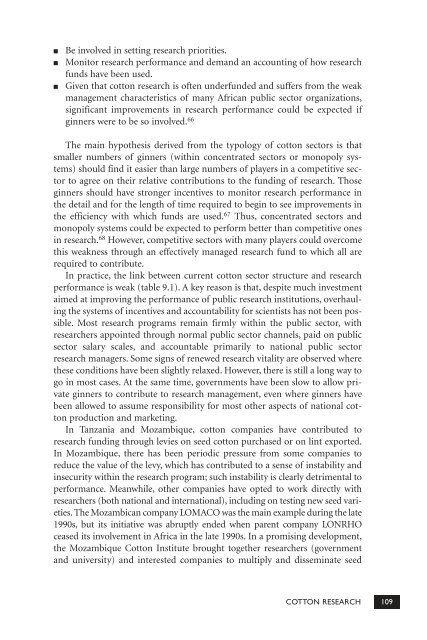Organization and Performance of Cotton Sectors in Africa ... - infoDev
Organization and Performance of Cotton Sectors in Africa ... - infoDev
Organization and Performance of Cotton Sectors in Africa ... - infoDev
You also want an ePaper? Increase the reach of your titles
YUMPU automatically turns print PDFs into web optimized ePapers that Google loves.
■■■Be <strong>in</strong>volved <strong>in</strong> sett<strong>in</strong>g research priorities.Monitor research performance <strong>and</strong> dem<strong>and</strong> an account<strong>in</strong>g <strong>of</strong> how researchfunds have been used.Given that cotton research is <strong>of</strong>ten underfunded <strong>and</strong> suffers from the weakmanagement characteristics <strong>of</strong> many <strong>Africa</strong>n public sector organizations,significant improvements <strong>in</strong> research performance could be expected ifg<strong>in</strong>ners were to be so <strong>in</strong>volved. 66The ma<strong>in</strong> hypothesis derived from the typology <strong>of</strong> cotton sectors is thatsmaller numbers <strong>of</strong> g<strong>in</strong>ners (with<strong>in</strong> concentrated sectors or monopoly systems)should f<strong>in</strong>d it easier than large numbers <strong>of</strong> players <strong>in</strong> a competitive sectorto agree on their relative contributions to the fund<strong>in</strong>g <strong>of</strong> research. Thoseg<strong>in</strong>ners should have stronger <strong>in</strong>centives to monitor research performance <strong>in</strong>the detail <strong>and</strong> for the length <strong>of</strong> time required to beg<strong>in</strong> to see improvements <strong>in</strong>the efficiency with which funds are used. 67 Thus, concentrated sectors <strong>and</strong>monopoly systems could be expected to perform better than competitive ones<strong>in</strong> research. 68 However, competitive sectors with many players could overcomethis weakness through an effectively managed research fund to which all arerequired to contribute.In practice, the l<strong>in</strong>k between current cotton sector structure <strong>and</strong> researchperformance is weak (table 9.1). A key reason is that, despite much <strong>in</strong>vestmentaimed at improv<strong>in</strong>g the performance <strong>of</strong> public research <strong>in</strong>stitutions, overhaul<strong>in</strong>gthe systems <strong>of</strong> <strong>in</strong>centives <strong>and</strong> accountability for scientists has not been possible.Most research programs rema<strong>in</strong> firmly with<strong>in</strong> the public sector, withresearchers appo<strong>in</strong>ted through normal public sector channels, paid on publicsector salary scales, <strong>and</strong> accountable primarily to national public sectorresearch managers. Some signs <strong>of</strong> renewed research vitality are observed wherethese conditions have been slightly relaxed. However, there is still a long way togo <strong>in</strong> most cases. At the same time, governments have been slow to allow privateg<strong>in</strong>ners to contribute to research management, even where g<strong>in</strong>ners havebeen allowed to assume responsibility for most other aspects <strong>of</strong> national cottonproduction <strong>and</strong> market<strong>in</strong>g.In Tanzania <strong>and</strong> Mozambique, cotton companies have contributed toresearch fund<strong>in</strong>g through levies on seed cotton purchased or on l<strong>in</strong>t exported.In Mozambique, there has been periodic pressure from some companies toreduce the value <strong>of</strong> the levy, which has contributed to a sense <strong>of</strong> <strong>in</strong>stability <strong>and</strong><strong>in</strong>security with<strong>in</strong> the research program; such <strong>in</strong>stability is clearly detrimental toperformance. Meanwhile, other companies have opted to work directly withresearchers (both national <strong>and</strong> <strong>in</strong>ternational), <strong>in</strong>clud<strong>in</strong>g on test<strong>in</strong>g new seed varieties.The Mozambican company LOMACO was the ma<strong>in</strong> example dur<strong>in</strong>g the late1990s, but its <strong>in</strong>itiative was abruptly ended when parent company LONRHOceased its <strong>in</strong>volvement <strong>in</strong> <strong>Africa</strong> <strong>in</strong> the late 1990s. In a promis<strong>in</strong>g development,the Mozambique <strong>Cotton</strong> Institute brought together researchers (government<strong>and</strong> university) <strong>and</strong> <strong>in</strong>terested companies to multiply <strong>and</strong> dissem<strong>in</strong>ate seedCOTTON RESEARCH 109
















